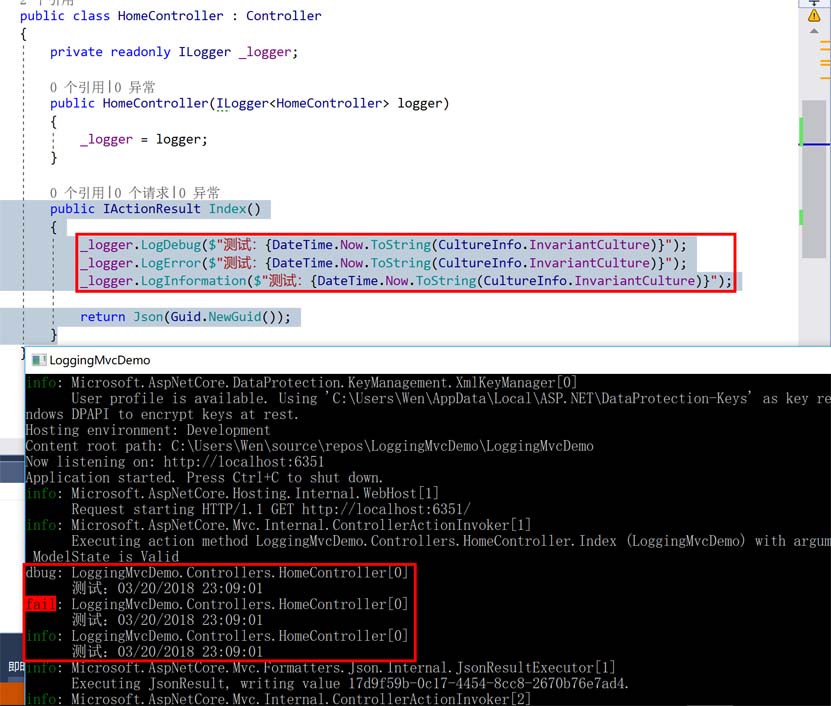您好,登錄后才能下訂單哦!
您好,登錄后才能下訂單哦!
小編給大家分享一下.Net Core之在Mvc中怎么使用日志組件,希望大家閱讀完這篇文章之后都有所收獲,下面讓我們一起去探討吧!
目錄
使用內置的日志組件
簡單過渡到第三方組件 - NLog
使用內置的日志
下面使用控制器 HomeController.cs 進行演示。
需要 using Microsoft.Extensions.Logging;
方案一:
public class HomeController : Controller
{
private readonly ILogger _logger ;
public HomeController(ILoggerFactory loggerFactory)
{
_logger = loggerFactory.CreateLogger(typeof(HomeController));
}
}方案二:
public class HomeController : Controller
{
private readonly ILogger _logger ;
public HomeController(ILogger<HomeController> logger)
{
_logger = logger;
}
}方案三:
public class HomeController : Controller
{
private readonly ILogger _logger ;
public HomeController(ILogger logger)
{
_logger = logger;
}
}三種都是通過注入的方式獲取日志記錄器對象,在過去,我們會自己獨立封裝類似這些 Debug、Info 和 Error 等不同日志等級的方法,現在我們看看內置的方法是如何使用的?
在 HomeController 內添加 Index() 方法進行測試。
public IActionResult Index()
{
_logger.LogDebug($"測試:{DateTime.Now.ToString(CultureInfo.InvariantCulture)}");
_logger.LogError($"測試:{DateTime.Now.ToString(CultureInfo.InvariantCulture)}");
_logger.LogInformation($"測試:{DateTime.Now.ToString(CultureInfo.InvariantCulture)}");
return Json(Guid.NewGuid());
}在輸出結果中我們可以看到,不同日志的等級在控制臺中會以不同的顏色進行標注。

每種級別的 Log 都有多個方法重載,如 LogInformation() ,示例演示的代碼中使用的是比較簡單一種,也就是最后一種。
// // 摘要: // Formats and writes an informational log message. // // 參數: // logger: // The Microsoft.Extensions.Logging.ILogger to write to. // // eventId: // The event id associated with the log. // // message: // Format string of the log message. // // args: // An object array that contains zero or more objects to format. public static void LogInformation(this ILogger logger, EventId eventId, string message, params object[] args); // // 摘要: // Formats and writes an informational log message. // // 參數: // logger: // The Microsoft.Extensions.Logging.ILogger to write to. // // exception: // The exception to log. // // message: // Format string of the log message. // // args: // An object array that contains zero or more objects to format. public static void LogInformation(this ILogger logger, Exception exception, string message, params object[] args); // // 摘要: // Formats and writes an informational log message. // // 參數: // logger: // The Microsoft.Extensions.Logging.ILogger to write to. // // message: // Format string of the log message. // // args: // An object array that contains zero or more objects to format. public static void LogInformation(this ILogger logger, string message, params object[] args);
其它細節以及詳情,或者希望使用其它日志組件可參考官方文檔:https://docs.microsoft.com/en-us/aspnet/core/fundamentals/logging/?tabs=aspnetcore2x
簡單過渡到第三方組件 - NLog
Nuget 安裝 NLog.Web.AspNetCore(目前 Nuget 最新為 4.4.1,但是官方的教程卻是 4.5 的,小編使用 4.4.1 進行演示)。如需 4.5+ 可參考官方:https://github.com/NLog/NLog.Web/wiki/Getting-started-with-ASP.NET-Core-2

下面演示如何將內置的組件簡單的移植到 NLog 中。
先在根目錄創建配置文件 nlog.config,記得將屬性修改成始終復制到目錄:
<?xml version="1.0" encoding="utf-8" ?>
<nlog xmlns="http://www.nlog-project.org/schemas/NLog.xsd"
xmlns:xsi="http://www.w3.org/2001/XMLSchema-instance"
autoReload="true"
internalLogLevel="info"
internalLogFile="c:\temp\internal-nlog.txt">
<!-- the targets to write to -->
<targets>
<!-- write logs to file -->
<target xsi:type="File" name="allfile" fileName="c:\temp\nlog-all-${shortdate}.log"
layout="${longdate}|${event-properties:item=EventId_Id}|${uppercase:${level}}|${logger}|${message} ${exception:format=tostring}" />
<!-- another file log, only own logs. Uses some ASP.NET core renderers -->
<target xsi:type="File" name="ownFile-web" fileName="c:\temp\nlog-own-${shortdate}.log"
layout="${longdate}|${event-properties:item=EventId_Id}|${uppercase:${level}}|${logger}|${message} ${exception:format=tostring}|url: ${aspnet-request-url}|action: ${aspnet-mvc-action}" />
</targets>
<!-- rules to map from logger name to target -->
<rules>
<!--All logs, including from Microsoft-->
<logger name="*" minlevel="Trace" writeTo="allfile" />
<!--Skip non-critical Microsoft logs and so log only own logs-->
<logger name="Microsoft.*" maxLevel="Info" final="true" /> <!-- BlackHole without writeTo -->
<logger name="*" minlevel="Trace" writeTo="ownFile-web" />
</rules>
</nlog>修改 Startup.cs 類中的 Configure() 方法,其它地方都不需要做出任何修改。
public void Configure(IApplicationBuilder app, IHostingEnvironment env, ILoggerFactory loggerFactory)
{
loggerFactory.AddNLog(); //添加NLog
env.ConfigureNLog("nlog.config"); //讀取Nlog配置文件
//...
}
啟動程序,你會發現:

看完了這篇文章,相信你對“.Net Core之在Mvc中怎么使用日志組件”有了一定的了解,如果想了解更多相關知識,歡迎關注億速云行業資訊頻道,感謝各位的閱讀!
免責聲明:本站發布的內容(圖片、視頻和文字)以原創、轉載和分享為主,文章觀點不代表本網站立場,如果涉及侵權請聯系站長郵箱:is@yisu.com進行舉報,并提供相關證據,一經查實,將立刻刪除涉嫌侵權內容。